Vue lecture
TWZ: Four Western firms stole Ukraine’s drone tech — Russia and China learned instead
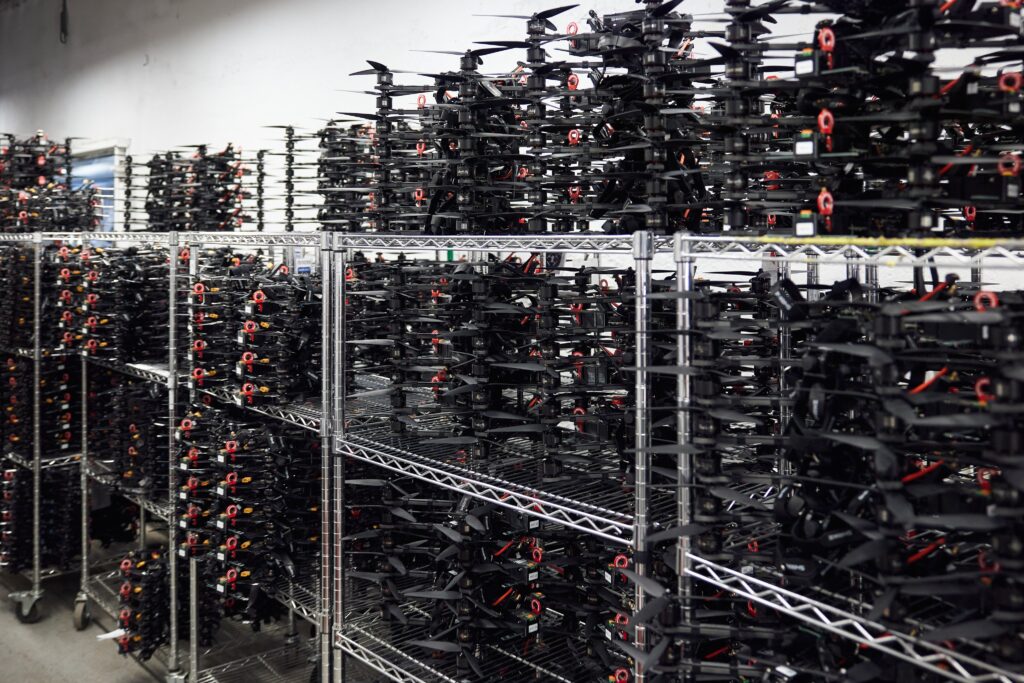
Ukraine turned wartime desperation into rapid defense innovation, fielding drones and autonomous systems at unprecedented speed. But the West isn’t learning fast enough, warns American investor Deborah Fairlamb, who co-founded Green Flag Ventures in Kyiv during the war.
Lacking long-range missiles and jets, Ukraine improvised an industry that rapidly designs, builds and fields everything from FPV drones to sea drones—closing capability gaps Russia once held.
“The lessons of success are being lost on or ignored by the US and NATO allies,” Fairlamb told The War Zone.
Battlefield innovation at breakneck speed
Fairlamb described how Ukraine’s defense ecosystem has evolved from almost nothing in 2022 to a network of small workshops and startups producing vast numbers of drones.
“The speed of iteration of everything is just extraordinary,” she said. “The Ukrainians have really had this incredible focus on homegrown drones… It’s navigation systems. It’s resistance to electronic warfare. It’s the ability to fly in GPS-denied environments.”
Unlike Western programs, these systems are created alongside soldiers at the front: build, test; build, test; build, test. By the time the Ministry of Defense sees them, they are already combat-proven. Procurement that once took years now takes three to four months.
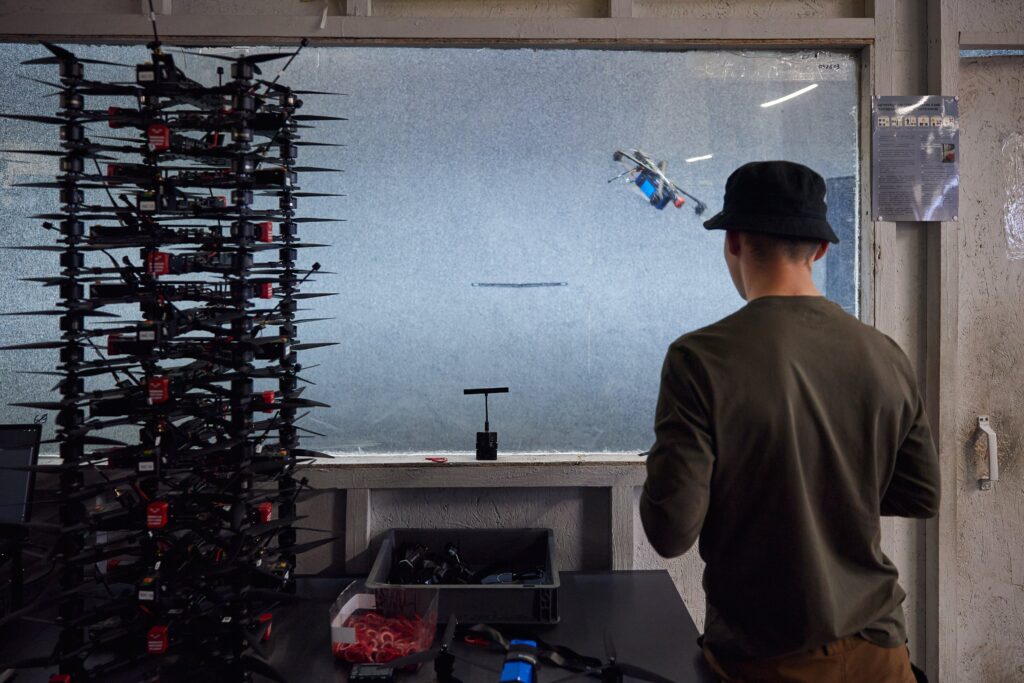
What Ukraine does differently
Fairlamb pointed to four battlefield-proven practices that Western defense establishments are ignoring:
- Rapid adaptation – systems change monthly, not yearly
- Decentralized production – thousands of small shops making parts
- Mass, low-cost systems – FPV drones cost $500–$1,000 instead of $100,000+
- Empowering units – frontline units buy directly from vetted suppliers
A model the West isn’t following
Fairlamb believes this speed is something the United States and NATO need to copy – and soon.
“The speed at which things are happening is just completely and utterly incompatible with the processes that exist in most Western systems,” she warned. “This is how Russia and China are going to fight. It is going to be just vast numbers of relatively low-price-point things that are extremely destructive.”
Instead, she sees allies trapped in slow cycles, expensive platforms, and outdated assumptions about war.
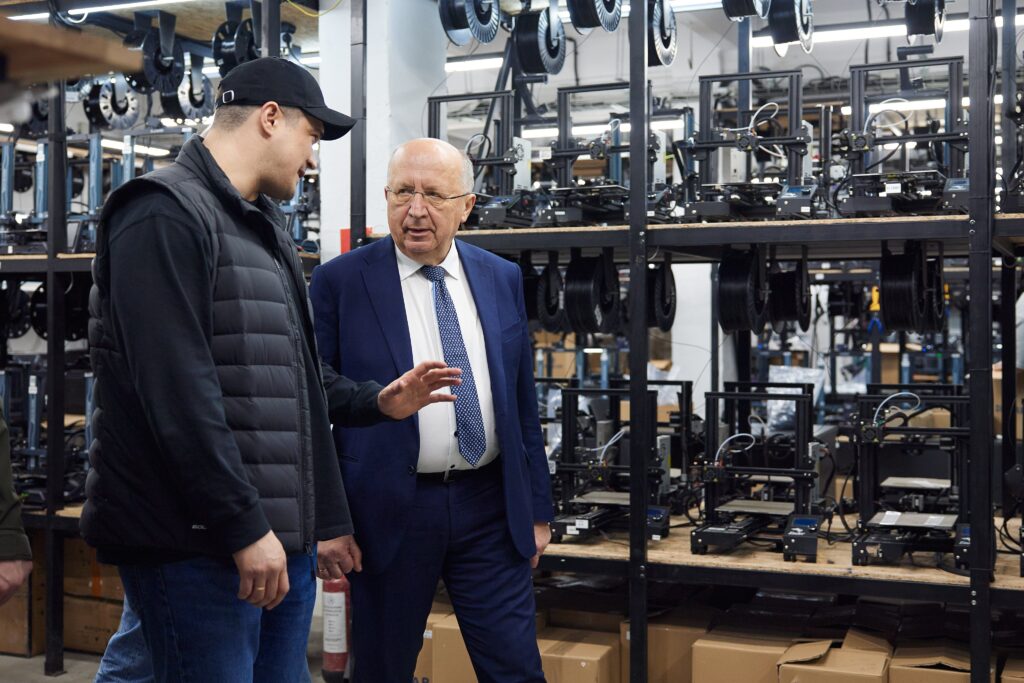
Copying without learning
Fairlamb also described a more troubling pattern from early in the war: Western companies arriving in Ukraine under the pretext of partnership, only to walk away and later release similar technology of their own.
“There have been instances… yes, there are Western companies that have come to Ukraine under the guise of: ‘hey, we would like to invest. We would like to partner. Can we spend a couple of days with you, learning what you’re doing?’ … And then they would essentially disappear. And six months later, they would come out with something that was very, very similar to what they wanted to partner with a company about,” Fairlamb said.
She said she personally knows of at least four examples.
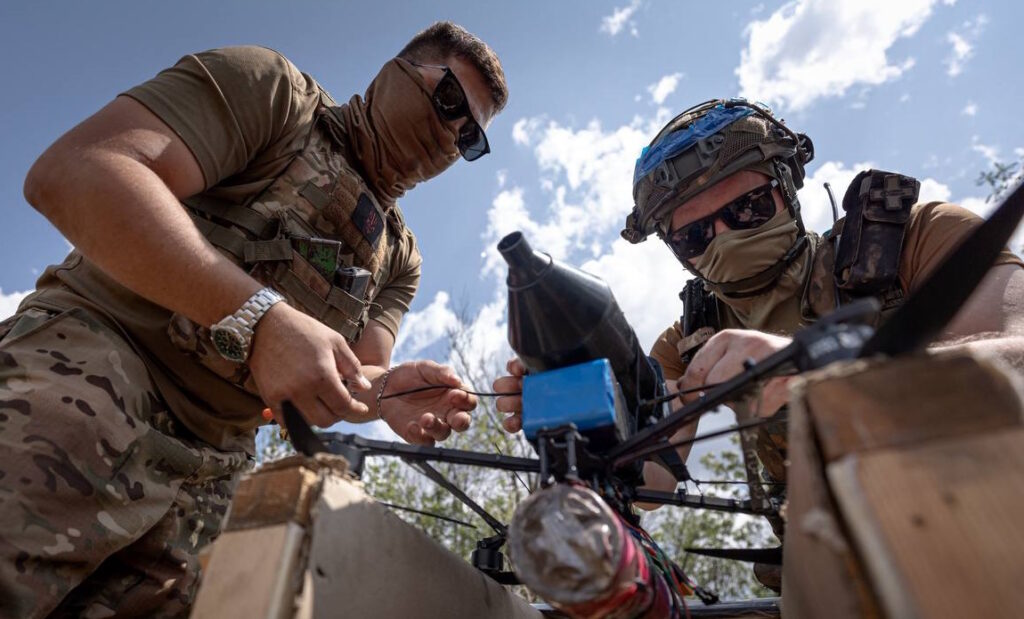
Low cost, high impact
The tools Ukraine has built are cheap and expendable. Most FPV drones cost between $500 and $1,000; larger fixed-wings cost a few thousand dollars. These drones are printed, assembled, modified and sent out in weeks, with new versions appearing on the front every month.
Fairlamb contrasted that with Western military systems, where a single drone might cost hundreds of thousands of dollars and require years to reach the field. That, she said, will not work against adversaries who are willing to mass-produce millions of small, smart, disposable machines.
A final warning
“The speed at which this technology is evolving, and that the US, Europe and NATO are all really slow,” she said. “There are a lot of very scary scenarios that are out there that I am not seeing a lot of response to yet.”
For Ukraine, drones have become the answer to weapons it does not have. For the West, Fairlamb’s warning is clear: pay attention, or risk falling behind in a kind of war that is already here.
120 secondes de Tech / 31 juillet 2025
China suggests lasers and stealth submarines to counter Elon Musk’s Starlink satellites
Teams are actively exploring methods to neutralise Elon Musk's Starlink satellite constellation

© Getty Images
120 secondes de Tech / 30 juillet 2025
Kyiv’s AI coders take aim at hidden Russia’s killers beneath soil
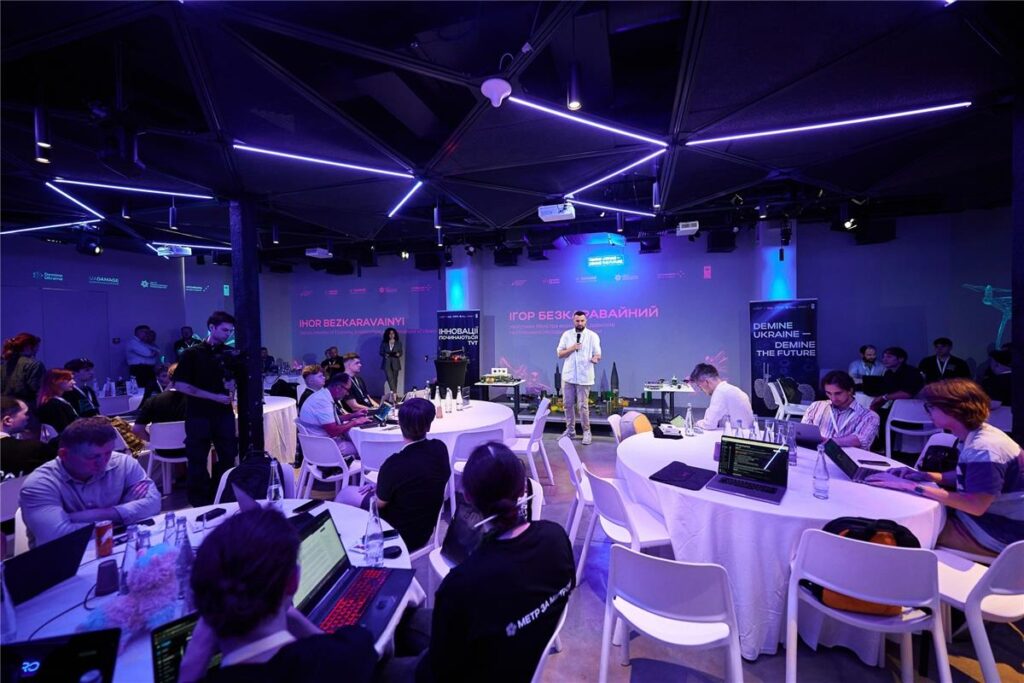
Ukrainian developers create algorithms to detect explosives from drone imagery. In Kyiv, 13 teams of engineers have built artificial intelligence capable of spotting landmines in drone imagery, a potential breakthrough for demining efforts, the Ministry of Economy, Environment, and Agriculture reports.
As of 2025, Ukraine is the most heavily mine-contaminated country in the world. Due to Russia’s war, nearly one-third of the country’s territory, an estimated 170,000 to 180,000 square kilometers, is considered mined. That’s roughly the size of half of Germany.
A game-changing competition
Over two days in Kyiv, the teams worked on training neural networks to automatically detect explosive objects. The competition, part of the second stage of the AI Data Jam, tasked participants with analyzing 8,000 training images and 23,000 test images depicting mine threats.
Mentorship was provided by experts from UADamage, The HALO Trust, and Dropla Tech.
The goal: a mine-free Ukraine, one meter at a time
“What began as an experiment has grown into a full-fledged project with international backing and tangible results,” says Deputy Economy Minister Ihor Bezkaravainyi.
There’s a huge motivation behind such AI lessons: to create a unique product that can help safely clear Ukraine of landmine pollution, leveraging cutting-edge technology without putting lives at risk.
Victory and deployment ahead
The winning team, MineWatch AI, developed the most accurate detection model. They received $2,000 in support from UNDP Ukraine and the Luxembourg government and the opportunity to further develop the system in partnership with professional demining experts.
All models and datasets from the challenge will contribute to refining AI algorithms. After successful testing, the technology is set to be integrated into humanitarian demining operations, speeding up and safeguarding the clearance of Ukraine’s contaminated lands.
Read also
-
Lithuania selects Ukrainian tech over alternatives to catch Russian drones following airspace violations
-
Ukraine’s tech revolution clashes with Russia’s massive military machine — result will define future of warfare
-
Zelenskyy: Russian missiles and drones still packed with Western tech — and still killing Ukrainians
-
Norwegian sea drone tech to be built in Ukraine to fight Russian navy
120 secondes de Tech / 29 juillet 2025
120 secondes de Tech / 28 juillet 2025
120 secondes de Tech / 25 juillet 2025
120 secondes de Tech / 24 juillet 2025
120 secondes de Tech / 23 juillet 2025
120 secondes de Tech / 22 juillet 2025
120 secondes de Tech / 21 juillet 2025
Russo-Ukrainian war, day 1241: Zaluzhnyi warns Ukraine has time until 2027 to revolutionize war strategy or face defeat
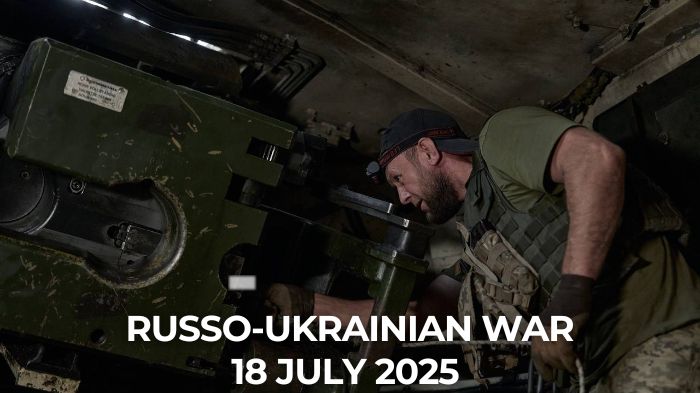
Exclusive
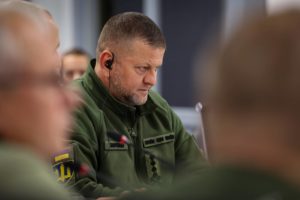 |
“A completely new kind of war lies ahead” so Ukraine must outhink Russia by 2027, says Zaluzhnyi. Ukraine’s survival depends on revolutionary strategy, not traditional firepower, Valerii Zaluzhnyi writes |
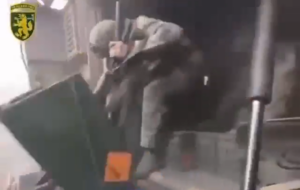 |
Ukraine’s MaxxPro trucks drop troops in 20 seconds—because drones don’t need more. Just reaching the front in Ukraine is now as deadly as holding it—thanks to drones that strike in seconds. Ground robots could be part of the answer. |
 |
“Just 16 people”: Ukraine’s new wartime cabinet is now smaller than many startups. Parliament approved a downsized government lineup on Wednesday, streamlining wartime leadership without altering the political balance of power. |
Military
Russia’s “human safari” drone smashes into rabbi’s vehicle — family in car survives direct hit
. A Russian FPV attack failed to kill its target, as Kherson’s Jewish leader escapes harm.
Russia kills Ukrainian railway worker with Shahed drone in scaled-down attack. From 400 drones on 16 July to just 35 launched last night—but impacts across three oblasts still hurt civilians and caused damage.
As of 18 July 2025, the approximate losses of weapons and military equipment of the Russian Armed Forces from the beginning of the invasion to the present day:
- Personnel: 1039830 (+1180)
- Tanks: 11032 (+3)
- APV: 23005 (+9)
- Artillery systems: 30485 (+47)
- MLRS: 1441 (+1)
- Anti-aircraft systems: 1197
- Aircraft: 421
- Helicopters: 340
- UAV: 46549 (+135)
- Cruise missiles: 3491
- Warships/boats: 28
- Submarines: 1
- Vehicles and fuel tanks: 55494 (+111)
Intelligence and technology
New Ukrainian PM Svyrydenko: Kyiv, Washington to launch joint drone deal under Trump-Zelenskyy mega pact. The deal aims to pair American weapons deliveries with Ukrainian UAV exports.
. They sound human and post nonstop.
Russia’s drones now target civilians with napalm firebombs that burn through sand and cannot be extinguished. Modified drones are designed for maximum civilian terror and violate all rules of urban warfare, says a Ukrainian military expert.
Romania wants to build drones with Ukraine—but can’t fund it before 2026. The country’s defense ministry confirms talks, but the production start hinges entirely on next year’s military budget.
France to train more Ukrainian pilots on Mirage fighter jets, capable of carrying missiles that destroy Russian command posts. Armed with 2,900-pound SCALP-EGs, Ukraine aims to shatter Russia’s coordination hubs deep behind the frontlines, due to expanded Franco-Ukrainian air cooperation.
Ukraine to get Patriot missiles “very shortly,” Merz says. The Chancellor confirms Germany’s air-defense transfer will happen within weeks as NATO works out logistics.
International
London also slashes price cap on Russian oil to $47.60 per barrel after EU’s sanctions adoption
. Western allies have escalated economic pressure on Russia by dropping the crude oil price cap.
UK forms second “NATO” inside Alliance amid fears of 2027 global conflict with Russia and China. In just one week, Britain has sealed two landmark defense deals with France and Germany, forming a new trilateral military bloc.
From adrenaline seekers to war veterans: New book of British journalist shows diverse faces of Ukraine’s International Legion. Volunteers worldwide joined the fight against Russian aggression, risking everything to defend Ukraine. Some have never returned home.
International Fencing Federation seeks to reinstate Russian thletes — even those who support killing of Ukrainians. The organization says move promotes “unity,” but critics call it a whitewash for Putin’s military machine.
EU agrees on new Russia sanctions package targeting energy and finance. Ambassadors greenlight the 18th sanctions round ahead of formal Council approval: Malta and Slovakia dropped their vetoes after receiving key guarantees.
Political and legal developments
. Many of them were children.
Kremlin’s mouthpiece calls Europeans “imbeciles,” says strikes on Kyiv will intesify after EU imposed new sanctions against Putin’s war machine. Former Russian President Dmitry Medvedev unleashed a grotesque tirade against Ursula von der Leyen, the president of the European Commission, mocking her medical background.
Zelenskyy installs ex-defense minister Umierov to run Security Council. The man once in charge of defense now oversees war tech, arms deals, and talks.
ISW: Russia is “burning the candle at both ends”—bankers quietly brace for bailouts. Russia’s top financial execs reportedly fear a growing debt crisis despite Central Bank claims of stability.
Read our earlier daily review here.
You could close this page. Or you could join our community and help us produce more materials like this.
We keep our reporting open and accessible to everyone because we believe in the power of free information. This is why our small, cost-effective team depends on the support of readers like you to bring deliver timely news, quality analysis, and on-the-ground reports about Russia's war against Ukraine and Ukraine's struggle to build a democratic society.
Become a patron or see other ways to support.
“It’s a devil’s machine.”
Tech leaders say AI will bring us eternal life, help us spread out into the stars, and build a utopian world where we never have to work. They describe a future free of pain and suffering, in which all human knowledge will be wired into our brains. Their utopian promises sound more like proselytizing than science, as if AI were the new religion and the tech bros its priests. So how are real religious leaders responding?
As Georgia's first female Baptist bishop, Rusudan Gotsiridze challenges the doctrines of the Orthodox Church, and is known for her passionate defence of women’s and LGBTQ+ rights. She stands at the vanguard of old religion, an example of its attempts to modernize — so what does she think of the new religion being built in Silicon Valley, where tech gurus say they are building a superintelligent, omniscient being in the form of Artificial General Intelligence?
Gotsiridze first tried to use AI a few months ago. The result chilled her to the bone. It made her wonder if Artificial Intelligence was in fact a benevolent force, and to think about how she should respond to it from the perspective of her religious beliefs and practices.
In this conversation with Coda’s Isobel Cockerell, Bishop Gotsiridze discusses the religious questions around AI: whether AI can really help us hack back into paradise, and what to make of the outlandish visions of Silicon Valley’s powerful tech evangelists.

This conversation took place at ZEG Storytelling Festival in Tbilisi in June 2025. It has been lightly edited and condensed for clarity.
Isobel: Tell me about your relationship with AI right now.
Rusudan: Well, I’d like to say I’m an AI virgin. But maybe that’s not fully honest. I had one contact with ChatGPT. I didn’t ask it to write my Sunday sermon. I just asked it to draw my portrait. How narcissistic of me. I said, “Make a portrait of Bishop Rusudan Gotsiridze.” I waited and waited. The portrait looked nothing like me. It looked like my mom, who passed away ten years ago. And it looked like her when she was going through chemo, with her puffy face. It was really creepy. So I will think twice before asking ChatGPT anything again. I know it’s supposed to be magical... but that wasn’t the best first date.

Isobel: What went through your mind when you saw this picture of your mother?
Rusudan: I thought, “Oh my goodness, it’s really a devil’s machine.” How could it go so deep? Find my facial features and connect them with someone who didn’t look like me? I take more after my paternal side. The only thing I could recognize was the priestly collar and the cross. Okay. Bishop. Got it. But yes, it was really very strange.
Isobel: I find it so interesting that you talk about summoning the dead through Artificial Intelligence. That’s something happening in San Francisco as well. When I was there last summer, we heard about this movement that meets every Sunday. Instead of church, they hold what they call an “AI séance,” where they use AI to call up the spirit world. To call up the dead. They believe the generative art that AI creates is a kind of expression of the spirit world, an expression of a greater force.
They wouldn’t let us attend. We begged, but it was a closed cult. Still, a bunch of artists had the exact same experience you had: they called up these images and felt like they were summoning them, not from technology, but from another realm.
Rusudan: When you’re a religious person dealing with new technologies, it’s uncomfortable. Religion — Christianity, Protestantism, and many others — has earned a very cautious reputation throughout history because we’ve always feared progress.
Remember when we thought printing books was the devil’s work? Later, we embraced it. We feared vaccinations. We feared computers, the internet. And now, again, we fear AI.
It reminds me of the old proverb about a young shepherd who loved to prank his friends by shouting “Wolves! Wolves!” until one day, the wolves really came. He shouted, but no one believed him anymore.
We’ve been shouting “wolves” for centuries. And now, I’m this close to shouting it again, but I’m not sure.
Isobel: You said you wondered if this was the devil’s work when you saw that picture of your mother. It’s quite interesting. In Silicon Valley, people talk a lot about AI bringing about the rapture, apocalypse, hell.
They talk about the real possibility that AI is going to kill us all, what the endgame or extinction risk of building superintelligent models will be. Some people working in AI are predicting we’ll all be dead by 2030.
On the other side, people say, “We’re building utopia. We’re building heaven on Earth. A world where no one has to work or suffer. We’ll spread into the stars. We’ll be freed from death. We’ll become immortal.”
I’m not a religious person, but what struck me is the religiosity of these promises. And I wanted to ask you — are we hacking our way back into the Garden of Eden? Should we just follow the light? Is this the serpent talking to us?
Rusudan: I was listening to a Google scientist. He said that in the near future, we’re not heading to utopia but dystopia. It’s going to be hell on Earth. All the world’s wealth will be concentrated in a small circle, and poverty will grow. Terrible things will happen, before we reach utopia.
Listening to him, it really sounded like the Book of Revelation. First the Antichrist comes, and then Christ.
Because of my Protestant upbringing, I’ve heard so many lectures about the exact timeline of the Second Coming. Some people even name the day, hour, place. And when those times pass, they’re frustrated. But they carry on calculating.
It’s hard for me to speak about dystopia, utopia, or the apocalyptic timeline, because I know nothing is going to be exactly as predicted.
The only thing I’m afraid of in this Artificial Intelligence era is my 2-year-old niece. She’s brilliant. You can tell by her eyes. She doesn’t speak our language yet. But phonetically, you can hear Georgian, English, Russian, even Chinese words from the reels she watches non-stop.
That’s what I’m afraid of: us constantly watching our devices and losing human connection. We’re going to have a deeply depressed young generation soon.
I used to identify as a social person. I loved being around people. That’s why I became a priest. But now, I find it terribly difficult to pull myself out of my house to be among people. And it’s not just a technology problem — it’s a human laziness problem.
When we find someone or something to take over our duties, we gladly hand them over. That’s how we’re using this new technology. Yes, I’m in sermon mode now — it’s a Sunday, after all.
I want to tell you an interesting story from my previous life. I used to be a gender expert, training people about gender equality. One example I found fascinating: in a Middle Eastern village without running water, women would carry vessels to the well every morning and evening. It was their duty.
Western gender experts saw this and decided to help. They installed a water supply. Every woman got running water in her kitchen: happy ending. But very soon, the pipeline was intentionally broken by the women. Why? Because that water-fetching routine was the only excuse they had to leave their homes and see their friends. With running water, they became captives to their household duties.
One day, we may also not understand why we’ve become captives to our own devices. We’ll enjoy staying home and not seeing our friends and relatives. I don’t think we’ll break that pipeline and go out again to enjoy real life.
Isobel: It feels like it’s becoming more and more difficult to break that pipeline. It’s not really an option anymore to live without the water, without technology.
Sometimes I talk with people in a movement called the New Luddites. They also call themselves the Dumbphone Revolution. They want to create a five-to-ten percent faction of society which doesn’t have a smartphone, and they say that will help us all, because it will mean the world will still have to cater to people who don’t participate in big tech, who don’t have it in their lives. But is that the answer for all of us? To just smash the pipeline to restore human connection? Or can we have both?
Rusudan: I was a new mom in the nineties in Georgia. I had two children at a time when we didn’t have running water. I had to wash my kids’ clothes in the yard in cold water, summer and winter. I remember when we bought our first washing machine. My husband and I sat in front of it for half an hour, watching it go round and round. It was paradise for me for a while.
Now this washing machine is there and I don't enjoy it anymore. It's just a regular thing in my life. And when I had to wash my son’s and daughter-in-law’s wedding outfits, I didn’t trust the machine. I washed those clothes by hand. There are times when it’s important to do things by hand.
Of course, I don’t want to go back to a time without the internet when we were washing clothes in the yard, but there are things that are important to do without technology.
I enjoy painting, and I paint quite a lot with watercolors. So far, I can tell which paintings are AI and which are real. Every time I look at an AI-made watercolour, I can tell it’s not a human painting. It is a technological painting. And it's beautiful. I know I can never compete with this technology.
But that feeling, when you put your brush in, the water — sometimes I accidentally put it in my coffee cup — and when you put that brush on the paper and the pigment spreads, that feeling can never be replaced by any technology.
Isobel:
As a writer, I'm now pretty good, I think, at knowing if something is AI-written or not. I'm sure in the future it will get harder to tell, but right now, there are little clues. There’s this horrible construction that AI loves: something is not just X, it’s Y. For example: “Rusudan is not just a bishop, she’s an oracle for the LGBTQ community in Georgia.” Even if you tell it to stop using that construction, it can’t. Same for the endless em-dashes: I can’t get ChatGPT to stop using them no matter how many times or how adamantly I prompt it. It's just bad writing.
It’s missing that fingerprint of imperfection that a human leaves: whether it’s an unusual sentence construction or an interesting word choice, I’ve started to really appreciate those details in real writing. I've also started to really love typos. My whole life as a journalist I was horrified by them. But now when I see a typo, I feel so pleased. It means a human wrote it. It’s something to be celebrated. It’s the same with the idea that you dip your paintbrush in the coffee pot and there’s a bit of coffee in the painting. Those are the things that make the work we make alive.
There’s a beauty in those imperfections, and that’s something AI has no understanding of. Maybe it’s because the people building these systems want to optimize everything. They are in pursuit of total perfection. But I think that the pursuit of imperfection is such a beautiful thing and something that we can strive for.
Rusudan: Another thing I hope for with this development of AI is that it’ll change the formula of our existence. Right now, we’re constantly competing with each other. The educational system is that way. Business is that way. Everything is that way. My hope is that we can never be as smart as AI. Maybe one day, our smartness, our intelligence, will be defined not by how many books we have read, but by how much we enjoy reading books, enjoy finding new things in the universe, and how well we live life and are happy with what we do. I think there is potential in the idea that we will never be able to compete with AI, so why don’t we enjoy the book from cover to cover, or the painting with the coffee pigment or the paint? That’s what I see in the future, and I’m a very optimistic person. I suppose here you’re supposed to say “Halleluljah!”
Isobel: In our podcast, CAPTURED, we talked with engineers and founders in Silicon Valley whose dream for the future is to install all human knowledge in our brains, so we never have to learn anything again. Everyone will speak every language! We can rebuild the Tower of Babel! They talk about the future as a paradise. But my thought was, what about finding out things? What about curiosity? Doesn’t that belong in paradise? Certainly, as a journalist, for me, some people are in it for the impact and the outcome, but I’m in it for finding out, finding the story—that process of discovery.
Rusudan: It’s interesting —this idea of paradise as a place where we know everything. One of my students once asked me the same thing you just did. “What about the joy of finding new things? Where is that, in paradise?” Because in the Bible, Paul says that right now, we live in a dimension where we know very little, but there will be a time when we know everything.
In the Christian narrative, paradise is a strange, boring place where people dress in funny white tunics and play the harp. And I understand that idea back then was probably a dream for those who had to work hard for everything in their everyday life — they had to chop wood to keep their family warm, hunt to get food for the kids, and of course for them, paradise was the place where they just could just lie around and do nothing.
But I don’t think paradise will be a boring place. I think it will be a place where we enjoy working.
Isobel: Do you think AI will ever replace priests?
Rusudan: I was told that one day there will be AI priests preaching sermons better than I do. People are already asking ChatGPT questions they’re reluctant to ask a priest or a psychologist. Because it’s judgment-free and their secrets are safe…ish. I don’t pretend I have all the answers because I don’t. I only have this human connection. I know there will be questions I cannot answer, and people will go and ask ChatGPT. But I know that human connection — the touch of a hand, eye-contact — can never be replaced by AI. That’s my hope. So we don’t need to break those pipelines. We can enjoy the technology, and the human connection too.
This conversation took place at ZEG Storytelling Festival in Tbilisi in June 2025.
Your Early Warning System
This story is part of “Captured”, our special issue in which we ask whether AI, as it becomes integrated into every part of our lives, is now a belief system. Who are the prophets? What are the commandments? Is there an ethical code? How do the AI evangelists imagine the future? And what does that future mean for the rest of us? You can listen to the Captured audio series on Audible now.
The post “It’s a devil’s machine.” appeared first on Coda Story.
China Is Buying Appliances and iPhones. What Happens When the Subsidies Stop?

© Kevin Frayer/Getty Images
120 secondes de Tech / 11 juillet 2025
120 secondes de Tech / 10 juillet 2025
120 secondes de Tech / 8 juillet 2025
120 secondes de Tech / 7 juillet 2025
120 secondes de Tech / 4 juillet 2025
Ukrainian-founded Grammarly to acquire AI email app Superhuman

Grammarly, a company with Ukrainian roots, announced its intent to acquire AI email writing app Superhuman as part of its expansion into an AI productivity platform, the company said in a press release on July 1.
Grammarly is the most valuable company with Ukrainian roots, reaching $13 billion valuation as of 2021. Grammarly was founded in 2009 in Kyiv by Oleksii Shevchenko, Maksym Lytvyn, and Dmytro Lider.
According to Grammarly's press release, email is Grammarly's top use case, with the platform editing over 50 million emails weekly.
Superhuman is an AI email application that the company says helps users respond to emails faster and reduces time spent on email communications.
Users are already sending and responding to 72% more emails per hour after using Superhuman compared to the previous period, according to Grammarly.
"This is the future we've been building toward since day one: AI that works where people work, not where companies want them to work," said Shishir Mehrotra, Grammarly's CEO.
The acquisition follows Grammarly's recent purchase of Coda, a productivity tool company. The combined platforms will allow users to work with multiple AI agents for different tasks within email communications.
Grammarly says that its service is used daily by over 40 million users, generating annual revenue of more than $700 million for the company.
 The Kyiv IndependentAbbey Fenbert
The Kyiv IndependentAbbey Fenbert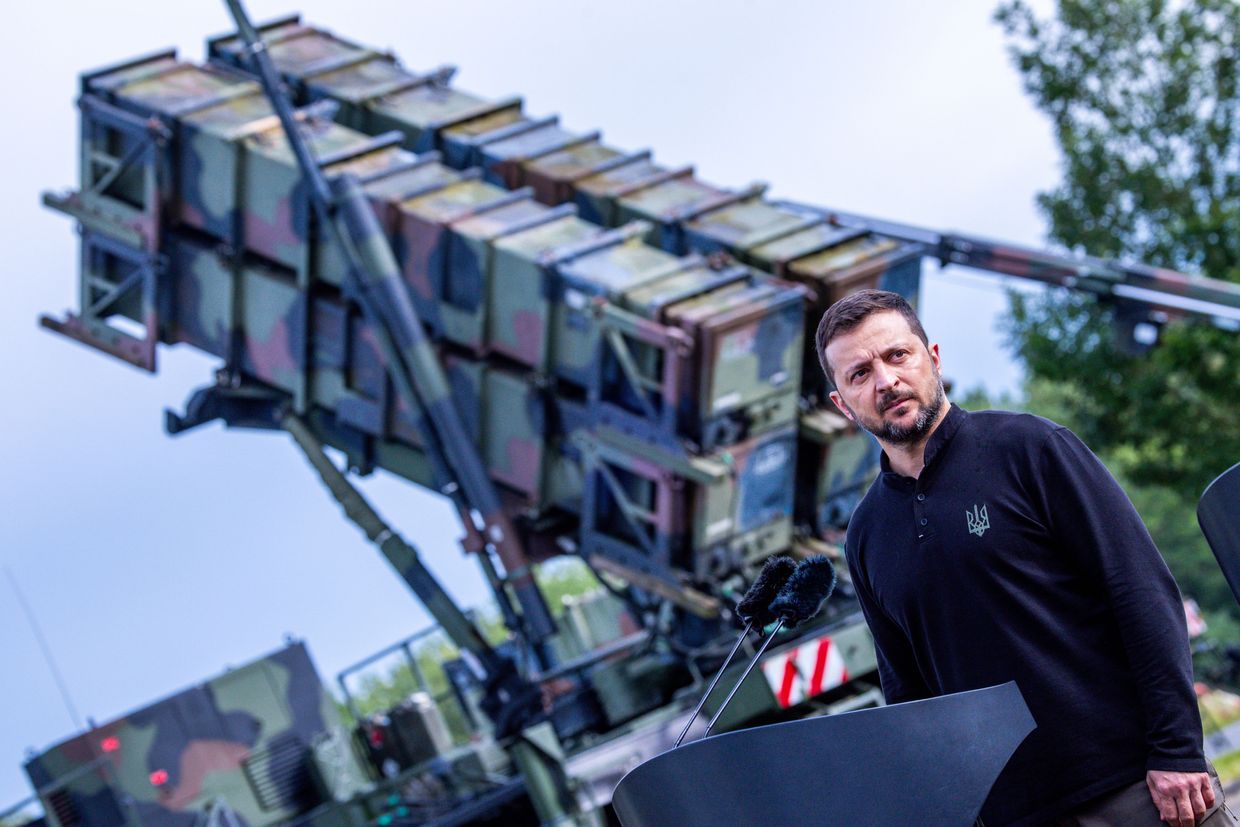
Russia cannot launch 500 drones every day, Ukraine's intel chief says
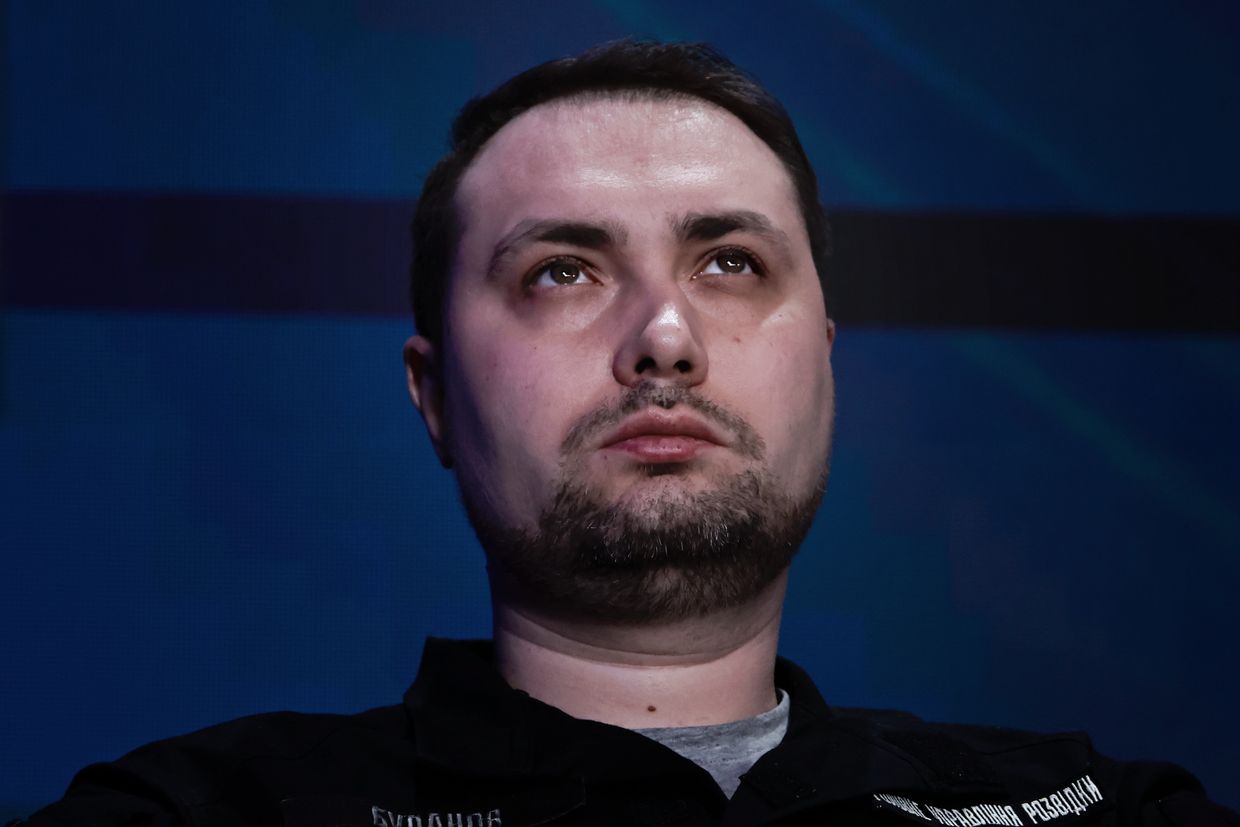
Russia has the capacity to launch as many as 500 Iranian-designed Shahed attack drones at Ukraine in a single attack, but doing so on a daily basis is not possible, Ukraine's military intelligence chief Kyrylo Budanov said on July 2, according to Suspilne.
In recent weeks, Russia has intensified its drone assaults on Ukrainian cities, often launching hundreds in a single day. The largest aerial attack since the start of the full-scale invasion occurred overnight on June 29, when Moscow launched 477 drones and 60 missiles across Ukraine.
"Launching 450–500 Shaheds every day — it's just not realistic," said Budanov during a ceremony recognizing five Ukrainian intelligence achievements in the national record book, according to public broadcaster Suspilne.
"But unfortunately, they do have the ability to do it periodically. They can realistically launch up to 500 in one strike," Budanov added.
Budanov also said Russia is upgrading the capabilities of the Shahed-type drones by improving their CRPA (Controlled Reception Pattern Antenna) systems, which protect the drones from GPS jamming. He noted that Russian engineers are now producing 16-channel CRPA antennas, which are harder to counter electronically.
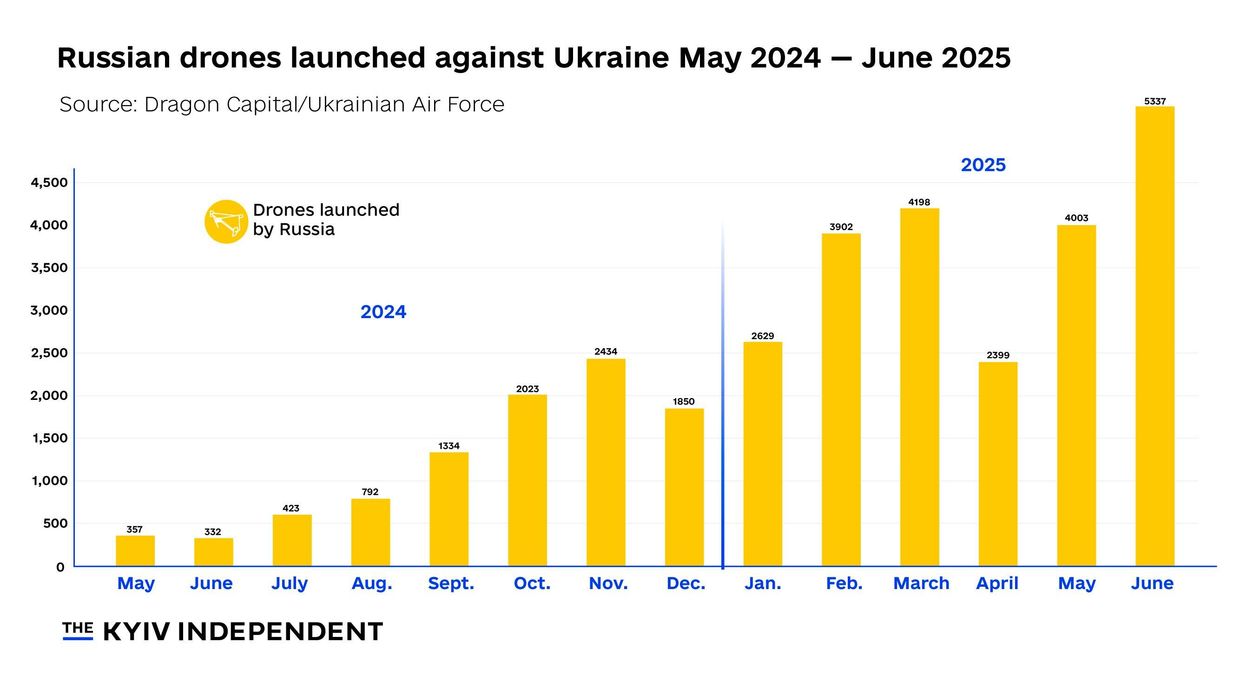
"These antennas are currently produced in Russia, but the engineer who developed this CRPA antenna was here in Ukraine," Budanov said.
"Back in the early 2000s, no one here needed it, so the engineer moved to Russia. One (of the two engineers involved in the development) has already died under unclear circumstances. The other is still alive, though probably not for long."
Russia has used thousands of Shahed-type drones throughout its full-scale invasion to strike Ukrainian cities and infrastructure, often in large overnight waves. Ukrainian air defenses have adapted over time but face growing challenges as Moscow improves drone resilience and electronic warfare capabilities.
President Volodymyr Zelensky said that Moscow has launched 28,743 Shahed-type drones at Ukraine since the start of Russia's full-scale invasion.
Budanov also said Russia has made unsuccessful attempts to develop its own naval drones. The last known effort came in early June, when experimental models detonated before reaching Ukrainian territorial waters, he said.
"They didn't achieve results. Based on our information, they were heading toward the city of Yuzhne, searching for targets," he said.
Ukraine has been using domestically developed Magura naval drones to target Russian military assets in the Black Sea, keeping much of Russia's fleet pinned in port.
Despite their small size, the unmanned surface vessels have proven effective, including in a May 2 operation when Ukraine's military intelligence used Magura-7 drones armed with air-to-air missiles to shoot down two Russian Su-30 fighter jets near Novorossiysk. It was the first recorded instance of fighter jets being downed by naval drones.
 The Kyiv IndependentMartin Fornusek
The Kyiv IndependentMartin Fornusek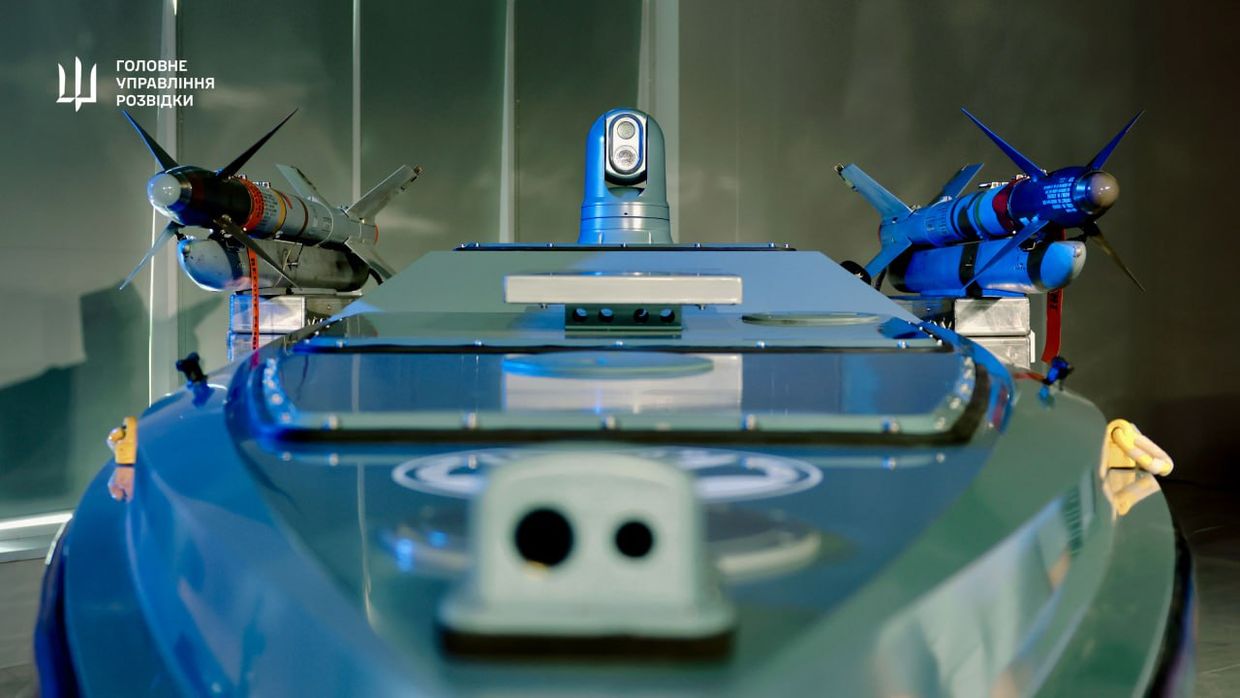
Ukraine approves new 'Murakha' ground robot for combat use

The Defense Ministry has approved the Ukrainian-made ground-based robotics complex "Murakha" ("Ant") for combat operations, the ministry announced on June 28.
Since 2024, Ukraine has been scaling up robotics development in hopes that mass production of unmanned ground vehicles (UGVs) will "minimize human involvement on the battlefield."
The Murakha is a tracked robotic platform designed to support front-line units working under challenging conditions, such as under enemy artillery and in heavily mined terrain, the Defense Ministry said.
Its larger size makes it one of Ukraine's leading UGVs in terms of load capacity. The Murakha can reportedly carry over half a ton of weight across dozens of kilometers. It can also cross difficult terrain and shallow water.
According to the Defense Ministry, the Murakha's multiple control channels allow it to function successfully even in areas of the battlefield where Russian electronic warfare (EW) systems are operating.
Mobile robots are capable of performing several tasks on the battlefield, including offensive and defensive activities, evacuation of the wounded, logistical support for units, and mining and demining.
In April, the Defense Ministry unveiled the D-21-12R UGV, a ground-based robot equipped with a machine gun.
 The Kyiv IndependentDmytro Basmat
The Kyiv IndependentDmytro Basmat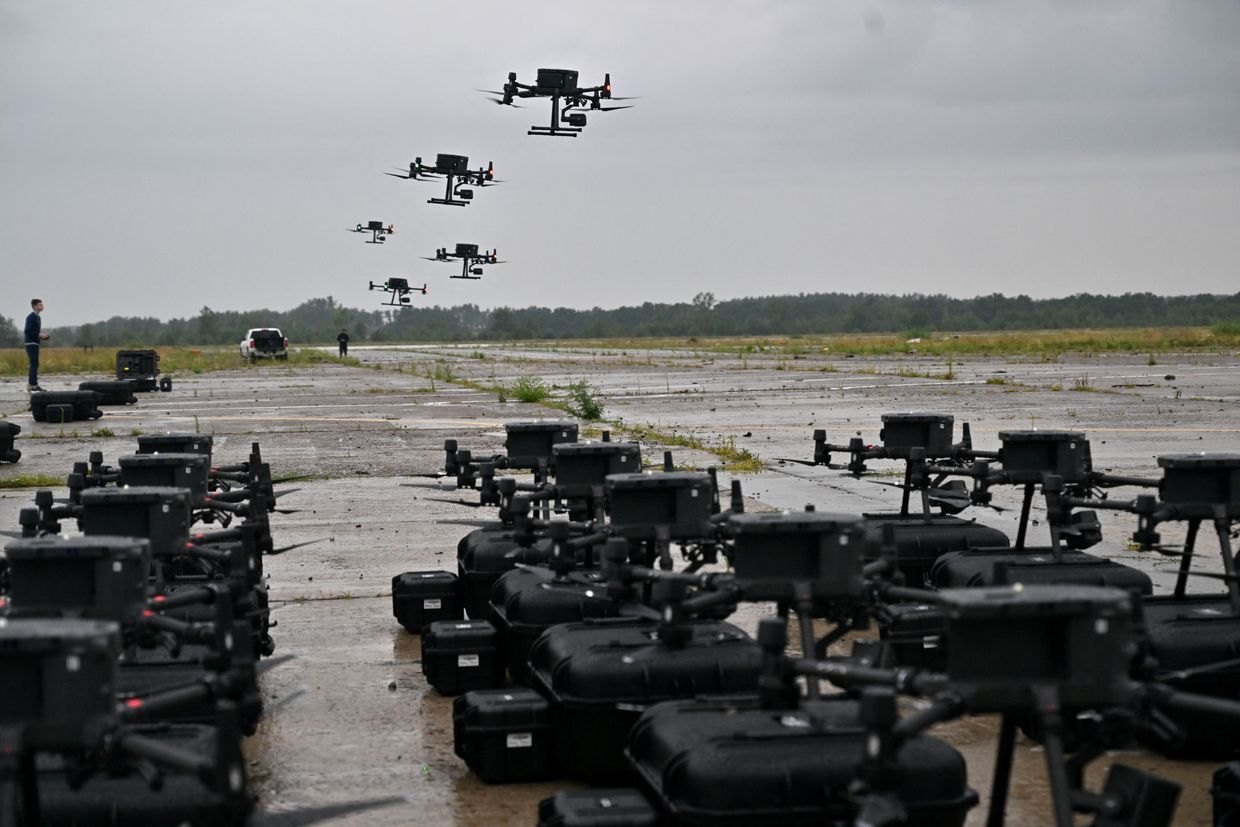
EU proposes integrating Ukraine into bloc's mobile roaming area
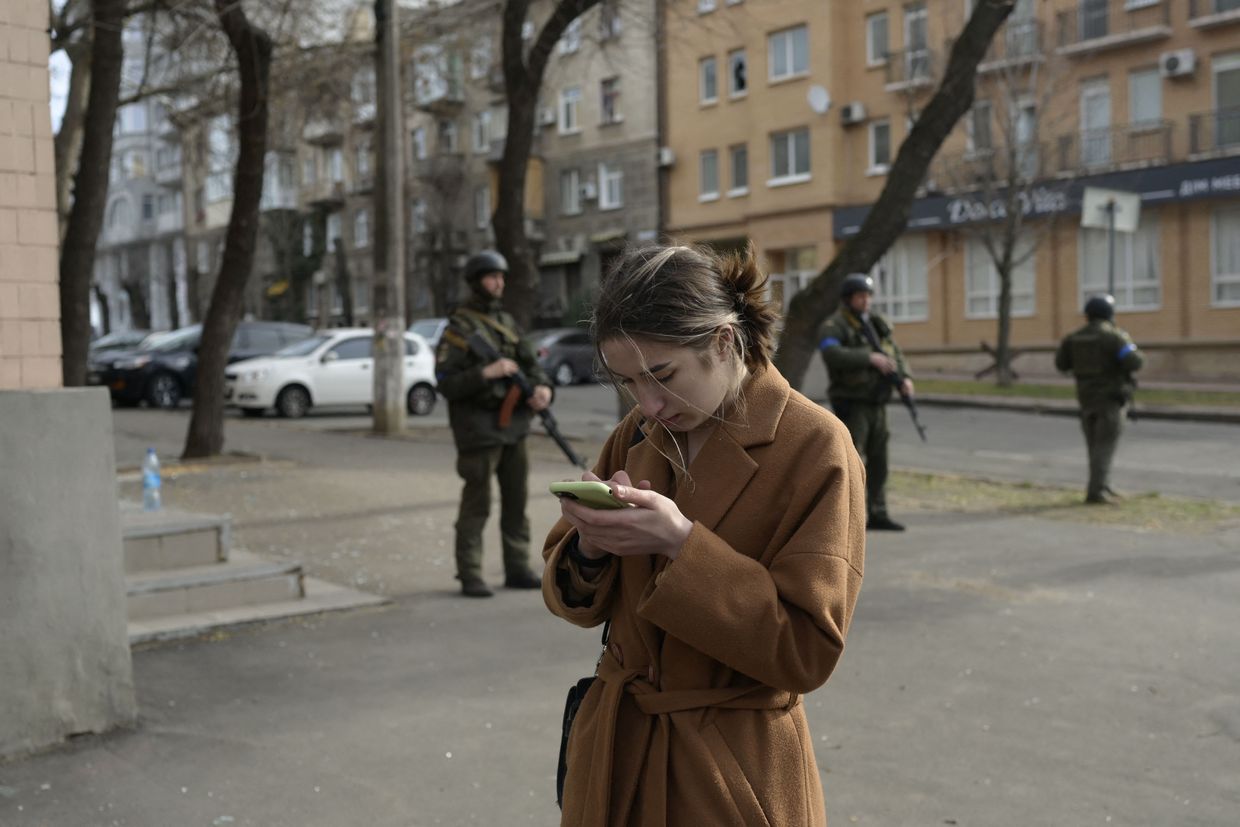
The European Commission has proposed that Ukraine join the European Union's mobile roaming area starting January 1, 2026, providing Ukrainian users the ability to make phone calls, texts, and use mobile data in the bloc's 27 countries at no extra charge.
"We want Ukrainian citizens to stay connected to their loved ones across the EU, as well as in their home country. That's why we propose that Ukraine join our roaming family," European Commission President Ursula von der Leyen said in a statement.
The proposal, first announced on June 16, will serve as a means of integration into the European Union's "Roam like at Home" provision in affect between all EU nations. The proposed change will impact the over four million Ukrainian refugees living in the EU.
Ukraine's full integration in the roaming provisions will replace voluntary measures that "allowed for roaming without surcharges and affordable international calls for EU and Ukrainian citizens abroad," according to the European Commission. The current measure will extend to December 31, 2025, ahead of the planned integration.
If approved, Ukraine will become the only country outside of the EU to join the bloc's "Roam like at Home" policy.
The move, which awaits European Council approval, comes as Ukraine continues to implement reforms in pursuing membership in the European Union.
Ukraine applied for EU membership at the onset of Russia's full-scale invasion in 2022. The country has made quick progress, achieving candidate status within months, with the initial negotiations formally launching in June 2024.
Since the start of 2025, Ukraine has opened three negotiation clusters under Poland's rotating presidency.
Poland lead the EU Council's presidency until June, and Denmark will take over the role in July. Ukraine aims to open the remaining three negotiation clusters in the second half of 2025 under the Danish chairmanship, the President Volodymyr Zelensky said.
There are six accession negotiation clusters, consisting of several individual chapters. Negotiations prepare a candidate country to become an EU member.
The EU’s Commissioner for Enlargement, Oliver Varhelyi, said that Ukraine could potentially join the bloc by 2029 if it successfully implements necessary reforms.
 The Kyiv IndependentVolodymyr Ivanyshyn
The Kyiv IndependentVolodymyr Ivanyshyn
VivaTech 2025 : "On utilise l’intelligence artificielle pour redonner goût à la lecture"

Alexandr Wang, la nouvelle star de l’IA qui présente (trop) bien

Salon VivaTech : Nvidia en tête d'affiche et Macron en défense de la "souveraineté technologique"

Guerre commerciale : à Londres, la Chine et les États-Unis s'entendent sur un "cadre général"

Welcome to the Technate
— Permalien